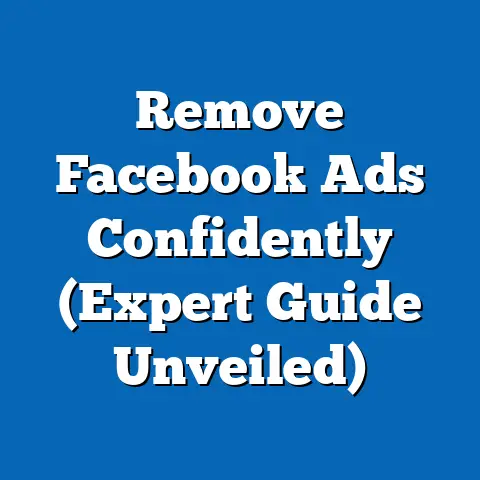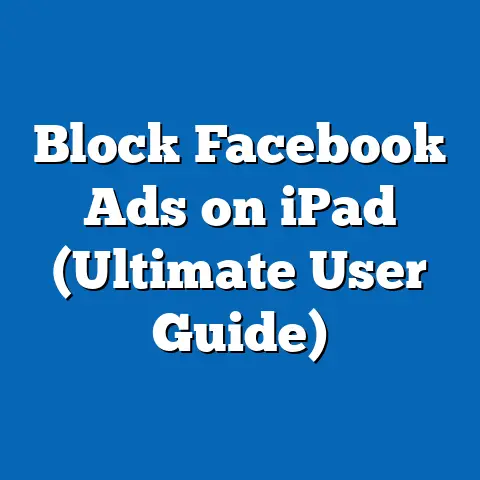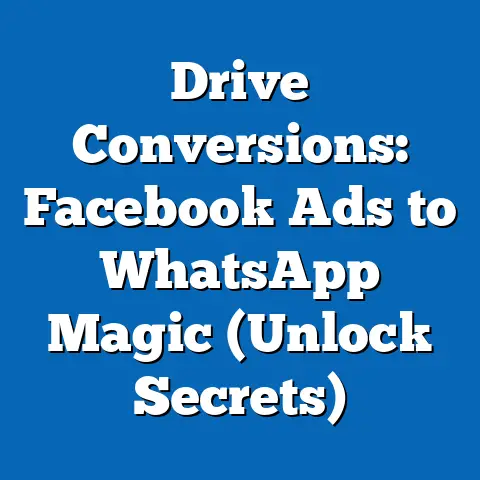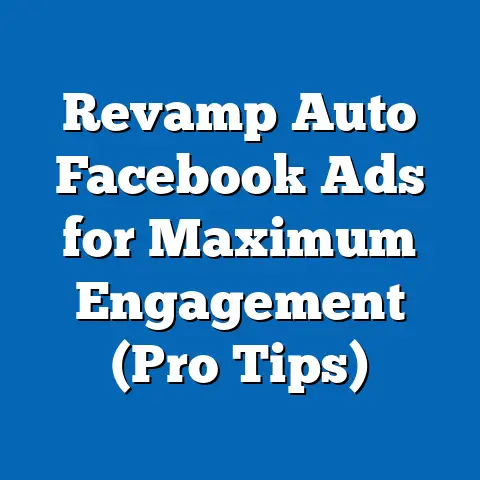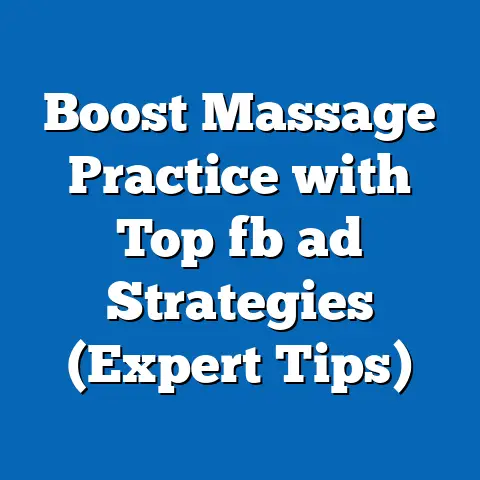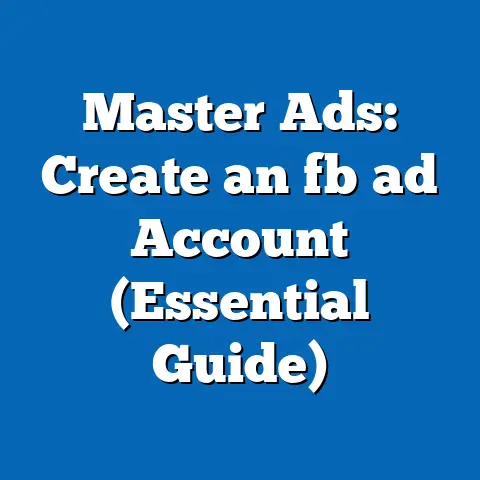Maximize fb ad Reach with Hashtags (Strategic Insights)
I remember the first Facebook ad campaign I ever launched. I was so excited, pouring hours into crafting the perfect copy and selecting what I thought were killer visuals. I hit ‘publish,’ eagerly anticipating a flood of new leads and customers. Crickets. The reach was abysmal. It felt like I was shouting into a void. That experience was a harsh, but valuable, lesson: Facebook advertising is more than just pretty pictures and catchy slogans. It’s about understanding the platform, your audience, and the subtle nuances that can make or break your campaign.
While hashtags are often associated with platforms like Instagram and Twitter, where they’re practically the lifeblood of content discovery, many marketers overlook their potential on Facebook. It’s a common misconception that Facebook’s algorithm renders hashtags irrelevant. But I’ve found, through trial and error, that strategically using hashtags in Facebook ads can significantly boost your reach and engagement.
The Importance of Hashtags in Social Media Marketing
Let’s face it, the internet is a chaotic sea of information. Hashtags act as navigational buoys, helping users and algorithms categorize and discover content. They’re essentially keywords that group conversations around specific topics. Think of them as digital signposts, directing interested parties to relevant content.
In the grand scheme of social media marketing, hashtags serve three primary purposes:
- Categorization: They help organize content, making it easier for users to find what they’re looking for.
- Discoverability: They increase the visibility of your content by exposing it to a wider audience interested in the tagged topics.
- Engagement: They encourage participation in conversations and foster a sense of community around shared interests.
I’ve personally witnessed the power of hashtags in my Instagram marketing efforts. For instance, I once ran a campaign for a local coffee shop, using a mix of generic hashtags like #coffee and #latteart, along with location-specific tags like #citynamecoffee and #coffeeshopname. The result? A significant increase in profile visits, follows, and even in-store traffic. We tapped into existing communities and conversations, instantly connecting with potential customers who were already interested in what the coffee shop had to offer.
This success on Instagram fueled my curiosity about the potential of hashtags on Facebook. While the platforms are vastly different, the underlying principle remained the same: connect with the right audience by participating in relevant conversations.
Understanding Facebook’s Algorithm and Hashtag Functionality
Facebook’s algorithm, the infamous gatekeeper of content visibility, is a complex beast. It prioritizes content that it believes users will find engaging, based on factors like relationship to the poster, type of content (video, image, text), and overall engagement metrics (likes, comments, shares). Understanding how hashtags fit into this equation is crucial for any marketer.
Unlike Twitter or Instagram, where hashtags are heavily relied upon for content discovery, Facebook’s algorithm primarily focuses on user connections and interests. This means that simply slapping a bunch of popular hashtags onto your Facebook ad won’t guarantee a massive boost in reach.
However, hashtags on Facebook still serve a purpose. They can help Facebook’s algorithm understand the context of your ad, making it more likely to show it to users who are genuinely interested in the topic. They can also make your ad more discoverable in Facebook’s search function.
In my early experiments, I noticed that ads with strategically chosen hashtags tended to perform better in terms of engagement and click-through rates. It wasn’t a dramatic overnight transformation, but a gradual improvement that suggested hashtags were indeed playing a role in connecting my ads with the right audience.
I’ve also observed a shift in how Facebook users interact with hashtags over the years. Initially, hashtags were met with skepticism and even ridicule. But as social media has become more integrated into our daily lives, users have become more accustomed to using and searching for hashtags on Facebook. This growing familiarity presents a unique opportunity for marketers to leverage hashtags to their advantage.
Key Takeaway: While Facebook’s algorithm is connection-based, hashtags can still enhance ad visibility and context.
Strategic Insights for Using Hashtags in Facebook Ads
Now, let’s get to the meat of the matter: how to strategically use hashtags in your Facebook ads to maximize reach and engagement. This isn’t about blindly adding trending hashtags; it’s about a thoughtful and data-driven approach.
Choosing the Right Hashtags
Selecting the right hashtags is paramount. It’s not about picking the most popular ones, but the most relevant ones. Here’s my process:
- Keyword Research: I start with traditional keyword research, using tools like Google Keyword Planner and Ahrefs to identify relevant keywords related to my product or service.
- Competitor Analysis: I analyze my competitors’ Facebook pages to see what hashtags they’re using. This gives me a sense of what’s working in my industry.
- Audience Research: I delve into my target audience’s interests and behaviors. What are they talking about online? What hashtags are they using? Facebook Audience Insights can be a goldmine of information here.
- Facebook Search: I use Facebook’s search function to see what conversations are happening around my chosen keywords. This helps me identify relevant hashtags that people are actually using.
For example, if I’m advertising a new line of vegan skincare products, I might start with broad hashtags like #veganskincare and #crueltyfreebeauty. But I’d also want to include more specific hashtags like #organicskincare, #plantbasedbeauty, and #ecofriendlybeauty. And, depending on my target audience, I might even include hashtags related to specific skin concerns, like #acnetreatment or #antiagingskincare.
Personal Tip: I always aim for a mix of broad and niche hashtags. Broad hashtags increase visibility, while niche hashtags target a more specific and engaged audience.
Creating Branded Hashtags
Branded hashtags are a powerful tool for fostering community and building brand awareness. They’re unique to your brand and encourage users to share content related to your products or services.
I once created a branded hashtag for a fitness studio I was working with: #StudioNameSweat. We encouraged members to use the hashtag when posting photos and videos of their workouts at the studio. This not only created a sense of community, but also generated user-generated content that we could then share on our own page.
Here are some tips for creating effective branded hashtags:
- Keep it Short and Memorable: The easier it is to remember, the more likely people are to use it.
- Make it Relevant: It should be related to your brand and what you offer.
- Promote it Everywhere: Include it in your ads, on your website, and in your social media posts.
- Monitor it Regularly: Keep an eye on what people are posting using your hashtag and engage with them.
Key Takeaway: Branded hashtags can transform your customers into brand advocates.
Mixing Popular and Niche Hashtags
As I mentioned earlier, a balanced approach is key. Using only popular hashtags might get your ad seen by a lot of people, but it also means it’s likely to get lost in the noise. Using only niche hashtags might target a highly engaged audience, but it could limit your overall reach.
I’ve found that a good rule of thumb is to aim for an 80/20 split: 80% niche hashtags and 20% popular hashtags. This allows you to tap into the broader conversation while still focusing on your target audience.
For example, if I’m promoting a new book on mindfulness, I might use hashtags like #mindfulness, #meditation, and #selfcare (popular hashtags). But I’d also include more specific hashtags like #mindfulparenting, #mindfuleating, and #stressreduction (niche hashtags).
Personal Experience: I once ran an ad campaign for a local bakery using only popular hashtags like #bakery and #food. The ad received a lot of impressions, but very few clicks or conversions. When I switched to a mix of popular and niche hashtags, like #bakery, #food, #artisanalbread, and #citynamebakery, the engagement and conversion rates skyrocketed.
Testing and Analyzing Hashtag Performance
The beauty of digital marketing is that everything is measurable. You can track the performance of your hashtags and adjust your strategy accordingly.
I use Facebook Ads Manager to monitor the performance of my ads, paying close attention to metrics like reach, engagement, click-through rate, and conversion rate. By comparing the performance of ads with different hashtag combinations, I can identify which hashtags are driving the best results.
I also use Facebook Analytics to track the overall performance of my Facebook page, including which hashtags are generating the most engagement.
Key Takeaway: Data is your best friend. Use it to refine your hashtag strategy and optimize your ad performance.
Practical Tip: A/B testing is your friend. Experiment with different hashtag combinations and track their performance to see what resonates best with your audience.
Case Studies and Real-World Applications
Let’s look at some real-world examples of how strategic hashtag use has impacted Facebook ad campaigns.
Case Study 1: Nike’s #JustDoIt Campaign
Nike’s #JustDoIt campaign is a classic example of a successful branded hashtag. It’s short, memorable, and perfectly encapsulates the brand’s message. Nike encourages its customers to use the hashtag when sharing their fitness achievements, creating a powerful sense of community and inspiring others to get active.
Learning Point: A well-crafted branded hashtag can become synonymous with your brand and drive user-generated content.
Case Study 2: A Local Restaurant’s #CityNameEats Campaign
A local restaurant in my city launched a campaign using the hashtag #CityNameEats. They encouraged customers to post photos of their meals at the restaurant using the hashtag. This not only generated buzz on social media, but also helped the restaurant attract new customers who were searching for local food recommendations.
Learning Point: Location-based hashtags can be incredibly effective for targeting local customers.
Case Study 3: My Own Experiment with a Travel Agency
I once worked with a travel agency that was struggling to reach its target audience on Facebook. I suggested using a mix of popular hashtags like #travel and #vacation, along with niche hashtags like #adventuretravel, #luxurytravel, and #familytravel. We also created a branded hashtag: #AgencyNameAdventures. The result was a significant increase in ad reach and engagement, leading to a surge in bookings.
Learning Point: Combining popular, niche, and branded hashtags can create a powerful synergy that drives results.
Conclusion
My journey with Facebook ads has been a rollercoaster, filled with both triumphs and setbacks. But one thing I’ve learned is that success in digital marketing requires constant experimentation, analysis, and adaptation.
Hashtags on Facebook might not be as crucial as they are on other platforms, but they can still play a significant role in maximizing your ad reach and engaging with your target audience. By following the strategies and insights I’ve shared in this article, you can leverage the power of hashtags to take your Facebook ad campaigns to the next level.
Remember, it’s not about blindly following trends; it’s about understanding your audience, testing different approaches, and analyzing the data to see what works best for your brand. So, go out there, experiment with hashtags, and see what magic you can create! And don’t be afraid to share your own experiences and insights along the way. After all, we’re all in this together.

